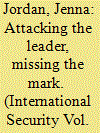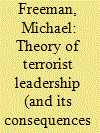| Srl | Item |
| 1 |
ID:
131111


|
|
|
|
|
| Publication |
2014.
|
| Summary/Abstract |
Leadership targeting has become a key feature of counterterrorism policy. Both academics and policymakers have argued that the removal of leaders is an effective strategy in combating terrorism. Leadership decapitation is not always successful, however, and existing empirical work does not account for this variability. A theory of organizational resilience explains why decapitation results in the decline of some terrorist organizations and the survival of others. Organizational resilience is dependent on two variables: bureaucratization and communal support. Older and larger organizations tend to develop bureaucratic features, facilitating a clear succession process and increasing their stability and ability to withstand attacks on their leadership. Communal support plays an important role in providing the resources necessary for terrorist groups to function and survive. Religious and separatist groups typically enjoy a high degree of support from the communities in which they operate, and thus access to critical resources. Application of this theoretical model to the case of al-Qaida reveals that Osama bin Laden's death and the subsequent targeting of other high-level al-Qaida operatives are unlikely to produce significant organizational decline.
|
|
|
|
|
|
|
|
|
|
|
|
|
|
|
|
| 2 |
ID:
133543


|
|
|
|
|
| Publication |
2014.
|
| Summary/Abstract |
States often target terrorist leaders with the belief that the leader's death or capture will cause the terrorist organization to collapse. Yet the history of this strategy of "leadership targeting" provides a mixed record-for every example of effectiveness, there are similar examples of ineffectiveness. The central question of this article is: what makes a terrorist leader important? Specifically, what does a terrorist leader do that no one else can do (or do as well) for the organization? To answer this question, I develop a theory of terrorist leadership that argues that leaders might potentially perform two main functions: they can provide inspiration and/or operational direction (or not for both). I also theorize as to how and why the provision of these functions changes over time as the organization itself changes. The consequences for leadership targeting flow naturally from this theory-when leaders provide these functions to the organization, leadership targeting is most likely to be effective. Case studies of Algeria, Peru, and Japan offer insights into why some cases of leadership targeting were effective and why others were not. The conclusion extends this model with an analysis of al-Qaeda's prospects after the death of bin Laden.
|
|
|
|
|
|
|
|
|
|
|
|
|
|
|
|